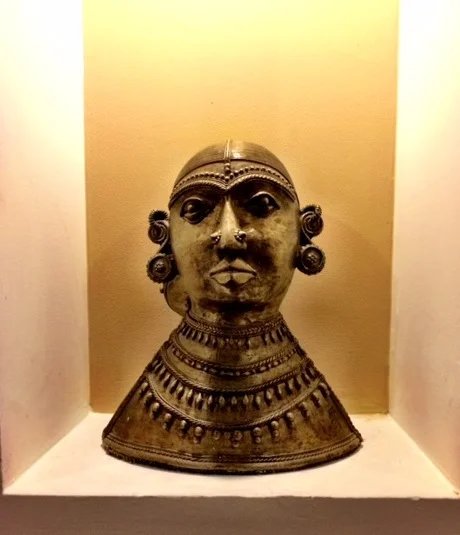The Gond people of central India pray to Mitki, depicted here in a Dhokra metalwork sculpture, to fulfill their desires
Star-crossed lovers met a gruesome demise — but at least some good art came out of it.
You could say it’s India’s version of Romeo and Juliet.
While staying at Lemon Tree hotel in Aurangabad, Wally and I oohed and ahhed over the many fine examples of the folk art showcased throughout. We were immediately drawn to the Dhokra metalwork sculptures, with their distinctive coiled surfaces and exaggerated, almost African vibe.
“In the morning, when the door was opened, he was found dead, much to the glory of the great goddess, who had shown her power by coming during the night and sucking his blood.”
We asked a hotel employee if we could buy similar sculptures locally but were told they came from another region. Disappointed, we made a mental note to keep an eye out for these on our next visit to India.
A Dhokra sculpture of a queen, found outside our room at the Lemon Tree hotel in Aurangabad, India
Waxing Poetic
These intricate pieces take their name from the Dhokra Damar, a tribe native to the ancient Indus Valley civilization of Mohenjo-daro in current Pakistan.
One of the oldest traditional techniques in the world, dating back 4,000 years, it’s still practiced today.
The artisans use coils of beeswax and resin, a distinctive hallmark of Dhokra metalwork figurines.
Using what’s known as the lost-wax casting method, the wax object is covered with layers of clay. This takes on the negative form of the wax inside and becomes the mold for the metal that will be poured inside it and cast.
Each mold can only be used once, as it is broken to remove the finished piece, making the finished sculpture one of a kind.
Appeasing a Bloody-Thirsty Goddess
The sculpture in the Lemon Tree’s lobby is Mitki, who according to popular folklore was a young girl with seven brothers who lived in the area of Bastar in central India.
As part of tradition, her brother brought home a young man to marry her. Mitki and Jhitku fell in love. But, as fate would have it, the brothers dreamed that the goddess, whom some believe to be a deification of the tiger, demanded a sacrifice.
The Gond people of central India did indeed once offer human sacrifices to the fearsome goddess Kali and to Danteshwari, the primary deity of the Bastar royal family. Human sacrifice supposedly continued into the 19th century, according to GluedIdeas.com.
Here’s how it went down: “The victim was taken to the temple after sunset and shut up within its dismal walls. In the morning, when the door was opened, he was found dead, much to the glory of the great goddess, who had shown her power by coming during the night and sucking his blood,” writes Maurice A. Canney in his 1921 tome, An Encyclopaedia of Religions.
The brothers couldn’t find anyone else suitable, so they sacrificed Jhitku. Poor Mitki could not bear losing her soulmate, so she killed herself.
To this day, devotees from the Gond people worship these figurines, known collectively as Jhitku Mitki, to have their wishes granted. –Duke






















